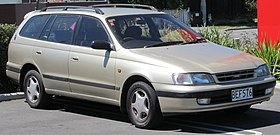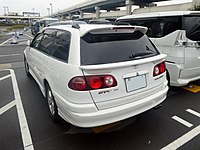Toyota Caldina
| Toyota Caldina | |
|---|---|
 2002-2004 Toyota Caldina GT-Four (ST246, Japan) | |
| Overview | |
| Manufacturer | Toyota |
| Production | November 1992 – June 2007 |
| Body and chassis | |
| Class | Compact car |
| Layout | |
| Chronology | |
| Predecessor | |
| Successor | Toyota Avensis wagon (T270) |
TheToyota Caldina(Japanese: トヨタ・カルディナ,Toyota Karudina)is an automobile manufactured byToyotafor the Japanese market from 1992 to 2007. It replaced theCoronaandCarinawagons, and was sold atToyota StoreandToyopet Storelocations in Japan. While the Caldina has never been officially exported by Toyota, itsAll-Trac4WD capability and large capacity have made it a popular grey import in Australia, New Zealand, Russia and many South American countries. When it was discontinued in 2007, theT270 series Avensiswagon/estate assumed its market position.
According to Toyota, the name "Caldina" is inspired by the Italian (and English) adjective "cardinal", meaning "essential" or "fundamental".[1]
First generation (T190; 1992)
[edit]| First generation | |
|---|---|
 Pre-facelift Toyota Caldina 2.0 TZ (ST191G) | |
| Overview | |
| Model code | T190 |
| Also called | Toyota Corona/Carina E (T190) |
| Production |
|
| Body and chassis | |
| Body style | 5-doorstation wagon/van |
| Powertrain | |
| Engine | |
| Transmission | |
| Dimensions | |
| Wheelbase | 2,580 mm (101.6 in) |
| Length | 4,545 mm (178.9 in) |
| Width | 1,695 mm (66.7 in) |
| Height | 1,450–1,555 mm (57.1–61.2 in) |
| Chronology | |
| Successor | Toyota Succeed(van) |
The first-generation Caldina is a 5-door wagon and commercial van version of the Corona/Carina sedan in Japan. It became treated as a separate line, with a new emphasis on the passenger-oriented station wagon model as a response to the runaway success of theSubaru Legacywagon in Japan. The Caldina was introduced in November 1992 and built until 2002. The wagon has independent strut rear suspension while the commercial wagon has semi-independentleaf springs.Van models' chassis numbers are in the 196-199 range and receive a "V" suffix, while the wagons are 190-195 and carry a "G" suffix. In January 1996, the Caldina underwent a subtle facelift, including a new dashboard, a new grille, and a redesigned bootlid with redesigned taillights. The new dashboard was the same design as the one installed in the simultaneously introducedCorona Premio (T210),enabling the fitment of a passenger airbag. At this time, the 1.8-litre engine was also changed over from the 4S to thelean-burn7A engine. The 2-litre 3S-FE engine produces 140 PS (103 kW), 135 PS (99 kW) when coupled with four-wheel drive. Arriving in February 1995, the more powerful, wide-angle 3S-GE in the TZ-G was only available with 4WD and produces 175 PS (129 kW), ten horsepower less when fitted with the automatic transmission.
Special versions of the Caldina Wagon included the Sky Canopy, introduced in February 1993. This version had a taller, partially glazed roof although it offered no additional space inside. It also could not accommodate most roof racks and by the time of the January 1996 facelift it was replaced with the Aerial, which has a taller roof to accommodate a 60 cm (24 in) long, sliding sunroof. The Aerial also received different headlights, with black "masks" between the reflectors, and clearer taillights with a more distinct, faceted pattern. The Aerial's head- and taillights were later installed on a number of run-out special editions including the Limited, Lanner, and Excellent Package.[2]The later Field Hunter cashed in on Japan's so-called "RV boom" - versions of station wagons and small vans with offroad pretensions. The Field Hunter received an externally mounted spare wheel, which increased the overall length to the point that it was no longer classified as a "compact car", placing it in a much higher tax category. The popularity of light, passenger-based commercial vehicles was waning at this time in Japan; theMark II Van (X70)was discontinued without a direct successor in 1997, leaving only the Crown and Caldina Vans. While sales of the Caldina Wagon ended in September 1997, the Van continued to be sold until July 2002.
The Caldina Van received another light facelift in August 1999, which is also when the naturally aspirated diesel was upgraded to a 2.2-litre version (the turbo-diesel was only ever available in the Caldina Wagon).[3]ABS brakes were made standard, while crash protection was improved. The 2-litre 3S-FE gasoline engine also became available in the Caldina Van, only in combination with the electronically controlled four-speed automatic transmission (ECT) and four-wheel drive.[4]
In Europe, the wagon was part of the Carina E family, while in New Zealand it was sold as the Corona. The vans were generally not exported. The 1.6-litre 4A engine (AT190) was only installed in export versions; these also typically kept the pre-facelift tailgate since the redesigned type was not able to accommodate the wider, European license plates.
-
Caldina Van
-
Caldina Van
-
Caldina 2.0 TZ 4WD (ST195G; facelift, Japan)
-
Caldina 2.0 TZ 4WD (ST195G; facelift, Japan)
-
Caldina 2.0 TZ Aerial (ST191G; facelift, Japan)
Second generation (T210; 1997)
[edit]| Second generation | |
|---|---|
 1997 Caldina 2.0 G (ST215G; pre-facelift) | |
| Overview | |
| Model code | T210 |
| Also called | Toyota Avensis (T220) |
| Production | September 1997 – September 2002 |
| Body and chassis | |
| Body style | 5-door station wagon |
| Related | |
| Powertrain | |
| Engine | |
| Power output |
|
| Transmission |
|
| Dimensions | |
| Wheelbase | 2,580 mm (101.6 in) |
| Length | 4,520 mm (178.0 in) |
| Width | 1,695–1,720 mm (66.7–67.7 in) |
| Height | 1,475–1,570 mm (58.1–61.8 in) |
| Kerb weight | 1,280 kg (2,822 lb) |
The second-generation Caldina is the Japanese version of the EuropeanAvensiswagon with door handles taken from theE110 series Corollaand theT210 series Corona Premio,launched in Japan in September 1997.
Engines include a 1.8 L7A-FEpetrol,the 2.0 L3S-FEpetrol and the 2.2 L3C-TEturbo-diesel.TheAll-Tracfour-wheel drivemodels are coded ST215, and were also offered as Active Sports GT models with the3S-GEengine. The top-of-the-line GT-T came with theturbocharged260 PS (191 kW; 256 hp) fourth-generation3S-GTEengine, and included aviscous-couplingall-wheel drive system similar to theCelica GT-Four.[5]The GT-T also came with optionalVSC(standard on Active Sports versions). Other options available on the GT and GT-T models included replacing the dashboard storage compartment with either Toyota'svoice navigation system,or a multi-function display.[6]Aerial versions of the Caldina feature a large sunroof and contoured roof racks as standard. Weighing 1,440 kg (3,175 lb), the manual Caldina GT-T has a 0–100 km/h (0–62 mph) time of 6.4 seconds, with the automatic version only 0.1 seconds slower.[7]
A refresh was given in 2000 with new plastic bumpers, plastic headlights, and updated taillights. The mostly-plastic interior was also updated with notable additions including a new white gauge cluster, as well as minor chrome and faux-wood touches to the 2.0G model, amongst other changes across the model range.
In 2001, an extra lug was added to the turbo manifold to prevent the manifold from warping which had been a common issue on GT-T models.[8]Reliability of the GT-T engines proved to be a concern throughout the lifespan of the3Spowered GT-Ts, with spun main bearings and shattered oil pump gears being common issues amongst owners.[citation needed]
-
2000 Caldina 2.0 E (ST215G; facelift, Japan)
-
Caldina 2.0 G 4WD (ST215G; facelift, Japan)
-
Caldina GT-T (ST215W; pre-facelift, Japan)
-
Caldina GT-T (ST215W; pre-facelift, Japan)
-
Caldina GT-T (ST215W; facelift, Japan)
Third generation (T240; 2002)
[edit]| Third generation | |
|---|---|
 2003 Caldina 1.8 X (ZZT241W; pre-facelift) | |
| Overview | |
| Model code | T240 |
| Production | September 2002 – June 2007 |
| Assembly | Japan:Toyota, Aichi(Tsutsumi plant)[9] |
| Designer | Shogo Tokutake and Tetsu Endo[10] |
| Body and chassis | |
| Body style | 5-door station wagon |
| Platform | Toyota MC platform |
| Related | |
| Powertrain | |
| Engine | |
| Power output |
|
| Transmission | 4-speed automatic |
| Dimensions | |
| Wheelbase | 2,700 mm (106.3 in) |
| Length | 4,510 mm (177.6 in) |
| Width | 1,740 mm (68.5 in) |
| Height | 1,445 mm (56.9 in) |
| Kerb weight | 1,240–1,490 kg (2,734–3,285 lb) |
The third-generation Caldina launched in September 2002 was marketed as a pure sports wagon and does not share body panels with Allion, Premio and Avensis.
Engines for the Caldina are 1.8 L1ZZ-FE,2.0 L1AZ-FSEand 2.0 L turbocharged3S-GTE.Trim levels are 1.8 X, 1.8 Z, 2.0 Z, 2.0 ZT and GT-Four. All models have an automatic transmission and the GT-Four model only comes in a tiptronic transmission.
The top-of-the-line Caldina carried the legendary Celica's trim level and engine. Like the older generations of Celica GT-Four, the only engine for the ST246 Caldina GT-Four is the 3S-GTE.
As a tribute to Toyota's motorsports development guru and the creator of the first Celica GT-Four,Hiromu Naruse,a special edition Caldina GT-Four was produced, the Caldina GT-Four N Edition (N for Naruse).[citation needed]This model was equipped with several performance enhancements specified by Naruse:[11]
- SportsABS
- Improved shocks and altered spring ratings
- Front upper strut bar
- Torsen rearLSD
- Recarofront seats and interior trim
Facelift was given in January 2005. The Caldina received restyled front end with the new bumper and grille, and the rear combination lamps were also revised.
-
Pre-facelift Caldina 2.0 ZT (AZT241)
-
Pre-facelift Caldina GT-Four (ST246)
-
Facelift Caldina ZT 4WD (AZT246W, Japan)
-
Facelift Caldina ZT 4WD (AZT246W, Japan)
Production of the third-generation Caldina ended in mid-2007 without a direct successor, but is indirectly replaced with the T270 series Avensis wagon/estate imported from the UK.
References
[edit]- ^"Data: Origin of a car's name".Toyota. 2012.Retrieved2020-04-14.
- ^カルディナ đặc biệt sĩ dạng xa[Caldina Special Editions] (catalog) (in Japanese), Toyota Motor Corporation, October 1996, pp. 3–9, TA2503-9610
- ^"Caldina Van: In-depth Vehicle Information, Specification".75 Years of TOYOTA: Vehicle Lineage.Toyota Motor Corporation.Retrieved2020-10-21.
- ^"トヨタ, カルディナ バンを nhất bộ cải lương | トヨタ tự động xa chu thức hội xã công thức xí nghiệp サイト".global.toyota.Retrieved2020-10-21.
- ^"Caldina 215 4WD".Eugenio,77.Retrieved2024-04-09.
- ^"Toyota Caldina 1997 T210".Toyota Motor Corporation.Retrieved2024-04-09.
- ^"Toyota Caldina GT-T".1001Moteurs. Archived fromthe originalon 2020-01-21.
- ^"3S-GTE Generations".Faster Than Jesus.Retrieved2015-11-27.
- ^"History of Kanto Auto Works".Kanto-aw.co.jp.Retrieved2010-07-16.
- ^US D520909,Tokutake, Shogo & Endo, Tetsu, "Motor vehicle and/or toy replica thereof", issued 2006-05-16, assigned to Toyota Jidosha Kabushiki Kaisha
- ^"Toyota Caldina GT-Four N — sports car of the New Age".2012-11-06.














